Evaluating Effects of Remotely Sensed Neighborhood Crowding and Depth-to-Water on Tree Height Growth
Abstract
1. Introduction
2. Materials and Methods
2.1. Study Area
2.2. Canopy Height Models
2.3. Neighborhood Crowding Indices
2.4. Depth-to-Water Maps
2.5. Growth Modelling
3. Results
3.1. Data Summary
3.2. Model Performance and Predictor Analysis
3.3. Stand Analysis
4. Discussion
4.1. Tree Size
4.2. Neighborhood Crowding Indices
4.3. Depth-to-Water
4.4. Potential Sources of Error
5. Conclusions
Author Contributions
Funding
Data Availability Statement
Acknowledgments
Conflicts of Interest
Abbreviations
| CHM | Canopy height model |
| DEM | Digital elevation model |
| DSM | Digital surface model |
| ELPD | The theoretical expected log pointwise predictive density |
| FIA | Flow initiation area |
| LOO | Leave one out cross-validation information criterion |
| UAV | Unmanned aerial vehicle |
| MDPI | Multidisciplinary Digital Publishing Institute |
| DOAJ | Directory of open access journals |
References
- Jose, S.; Bardhan, S. Agroforestry for biomass production and carbon sequestration: An overview. Agrofor. Syst. 2012, 86, 105–111. [Google Scholar] [CrossRef]
- Hall, D.B.; Clutter, M. Multivariate multilevel nonlinear mixed effects models for timber yield predictions. Biometrics 2004, 60, 16–24. [Google Scholar] [CrossRef] [PubMed]
- Briseño-Reyes, J.; Corral-Rivas, J.J.; Solis-Moreno, R.; Padilla-Martínez, J.R.; Vega-Nieva, D.J.; López-Serrano, P.M.; Vargas-Larreta, B.; Diéguez-Aranda, U.; Quiñonez-Barraza, G.; López-Sánchez, C.A. Individual Tree Diameter and Height Growth Models for 30 Tree Species in Mixed-Species and Uneven-Aged Forests of Mexico. Forests 2020, 11, 429. [Google Scholar] [CrossRef]
- Nothdurft, A.; Kublin, E.; Lappi, J. A non-linear hierarchical mixed model to describe tree height growth. Eur. J. For. Res. 2006, 125, 281–289. [Google Scholar] [CrossRef]
- Jiang, L.; Li, Y. Application of Nonlinear Mixed-Effects Modeling Approach in Tree Height Prediction. J. Comput. 2010, 5, 1575–1581. [Google Scholar] [CrossRef]
- Ritchie, M.W.; Hann, D.W. Development of a tree height growth model for Douglas-fir. For. Ecol. Manag. 1986, 15, 135–145. [Google Scholar] [CrossRef]
- Rozendaal, D.M.A.; Phillips, O.L.; Lewis, S.L.; Affum-Baffoe, K.; Alvarez-Davila, E.; Andrade, A.; Aragão, L.E.O.C.; Araujo-Murakami, A.; Baker, T.R.; Bánki, O.; et al. Competition influences tree growth, but not mortality, across environmental gradients in Amazonia and tropical Africa. Ecology 2020, 101, e03052. [Google Scholar] [CrossRef]
- Ren, J.; Fang, S.; Lin, G.; Lin, F.; Yuan, Z.; Ye, J.; Wang, X.; Hao, Z.; Fortunel, C. Tree growth response to soil nutrients and neighborhood crowding varies between mycorrhizal types in an old-growth temperate forest. Oecologia 2021, 197, 523–535. [Google Scholar] [CrossRef]
- El-Gizawy, A.; Gomaa, H.; El-Habbasha, K.; Mohamed, S. Effect of different shading levels on tomato plants 1. Growth, flowering and chemical composition. Acta Horticult. 1993. [Google Scholar] [CrossRef]
- Hara, T.; Kimura, M.; Kikuzawa, K. Growth patterns of tree height and stem diameter in populations of Abies veitchii, A. mariesii and Betula ermanii. J. Ecol. 1991, 79, 1085–1098. [Google Scholar] [CrossRef]
- Ma, Q.; Su, Y.; Tao, S.; Guo, Q. Quantifying individual tree growth and tree competition using bi-temporal airborne laser scanning data: A case study in the Sierra Nevada Mountains, California. Int. J. Digit. Earth 2018, 11, 485–503. [Google Scholar] [CrossRef]
- Østergaard Pedersen, R.; Bollandsås, O.M.; Gobakken, T.; Næsset, E. Deriving individual tree competition indices from airborne laser scanning. For. Ecol. Manag. 2012, 280, 150–165. [Google Scholar] [CrossRef]
- Lo, C.S.; Lin, C. Growth-competition-based stem diameter and volume modeling for tree-level forest inventory using airborne LiDAR data. IEEE Trans. Geosci. Remote Sens. 2012, 51, 2216–2226. [Google Scholar] [CrossRef]
- Vanderwel, M.C.; Lopez, E.L.; Sprott, A.H.; Khayyatkhoshnevis, P.; Shovon, T.A. Using aerial canopy data from UAVs to measure the effects of neighbourhood competition on individual tree growth. For. Ecol. Manag. 2020, 461, 117949. [Google Scholar] [CrossRef]
- Bassett, J.R. Tree growth as affected by soil moisture availability. Soil Sci. Soc. Am. J. 1964, 28, 436–438. [Google Scholar] [CrossRef]
- Silberstein, R.; Vertessy, R.; Morris, J.; Feikema, P. Modelling the effects of soil moisture and solute conditions on long-term tree growth and water use: A case study from the Shepparton irrigation area, Australia. Agric. Water Manag. 1999, 39, 283–315. [Google Scholar] [CrossRef]
- Murphy, P.N.; Ogilvie, J.; Connor, K.; Arp, P.A. Mapping wetlands: A comparison of two different approaches for New Brunswick, Canada. Wetlands 2007, 27, 846–854. [Google Scholar] [CrossRef]
- Murphy, P.; Ogilvie, J.; Arp, P. Topographic modelling of soil moisture conditions: A comparison and verification of two models. Eur. J. Soil Sci. 2009, 60, 94–109. [Google Scholar] [CrossRef]
- Oltean, G.S.; Comeau, P.G.; White, B. Linking the depth-to-water topographic index to soil moisture on boreal forest sites in Alberta. For. Sci. 2016, 62, 154–165. [Google Scholar] [CrossRef]
- Schönauer, M.; Väätäinen, K.; Prinz, R.; Lindeman, H.; Pszenny, D.; Jansen, M.; Maack, J.; Talbot, B.; Astrup, R.; Jaeger, D. Spatio-temporal prediction of soil moisture and soil strength by depth-to-water maps. Int. J. Appl. Earth Obs. Geoinf. 2021, 105, 102614. [Google Scholar] [CrossRef]
- Bjelanovic, I.; Comeau, P.G.; White, B. High resolution site index prediction in boreal forests using topographic and wet areas mapping attributes. Forests 2018, 9, 113. [Google Scholar] [CrossRef]
- Wang, G.; Marshall, P.; Klinka, K. Height growth pattern of white spruce in relation to site quality. For. Ecol. Manag. 1994, 68, 137–147. [Google Scholar] [CrossRef]
- Peterson, E.; Peterson, N.M. Ecology, Management, and Use of Aspen and Balsam Poplar in the Prairie Provinces; Canadian Electronic Library: Edmonton, AB, Canada, 1992. [Google Scholar]
- Amman, G.D. The role of the mountain pine beetle in lodgepole pine ecosystems: Impact on succession. In The Role of Arthropods in Forest Ecosystems; Springer: Berlin/Heidelberg, Germany, 1977; pp. 3–18. [Google Scholar]
- Carter, R.; Klinka, K. Variation in shade tolerance of Douglas fir, western hemlock, and western red cedar in coastal British Columbia. For. Ecol. Manag. 1992, 55, 87–105. [Google Scholar] [CrossRef]
- Williams, H.; Messier, C.; Kneeshaw, D.D. Effects of light availability and sapling size on the growth and crown morphology of understory Douglas-fir and lodgepole pine. Can. J. For. Res. 1999, 29, 222–231. [Google Scholar] [CrossRef]
- Man, R.; Greenway, K.J. Effects of soil moisture and species composition on growth and productivity of trembling aspen and white spruce in planted mixtures: 5-year results. New For. 2013, 44, 23–38. [Google Scholar] [CrossRef]
- Torres-Sánchez, J.; López-Granados, F.; Serrano, N.; Arquero, O.; Peña, J.M. High-throughput 3-D monitoring of agricultural-tree plantations with unmanned aerial vehicle (UAV) technology. PLoS ONE 2015, 10, e0130479. [Google Scholar] [CrossRef]
- Díaz-Varela, R.A.; De la Rosa, R.; León, L.; Zarco-Tejada, P.J. High-resolution airborne UAV imagery to assess olive tree crown parameters using 3D photo reconstruction: Application in breeding trials. Remote Sens. 2015, 7, 4213–4232. [Google Scholar] [CrossRef]
- Lisein, J.; Pierrot-Deseilligny, M.; Bonnet, S.; Lejeune, P. A photogrammetric workflow for the creation of a forest canopy height model from small unmanned aerial system imagery. Forests 2013, 4, 922–944. [Google Scholar] [CrossRef]
- Karpina, M.; Jarząbek-Rychard, M.; Tymków, P.; Borkowski, A.; Tymków, P.; Borkowski, A. UAV-based automatic tree growth measurement for biomass estimation. Int. Arch. Photogramm. Remote Sens. Spat. Inf. Sci. 2016, 8, 685–688. [Google Scholar] [CrossRef]
- Dempewolf, J.; Nagol, J.; Hein, S.; Thiel, C.; Zimmermann, R. Measurement of within-season tree height growth in a mixed forest stand using UAV imagery. Forests 2017, 8, 231. [Google Scholar] [CrossRef]
- Krause, S.; Sanders, T.G.; Mund, J.P.; Greve, K. UAV-based photogrammetric tree height measurement for intensive forest monitoring. Remote Sens. 2019, 11, 758. [Google Scholar] [CrossRef]
- Panagiotidis, D.; Abdollahnejad, A.; Surovỳ, P.; Chiteculo, V. Determining tree height and crown diameter from high-resolution UAV imagery. Int. J. Remote Sens. 2017, 38, 2392–2410. [Google Scholar] [CrossRef]
- Zarco-Tejada, P.J.; Diaz-Varela, R.; Angileri, V.; Loudjani, P. Tree height quantification using very high resolution imagery acquired from an unmanned aerial vehicle (UAV) and automatic 3D photo-reconstruction methods. Eur. J. Agron. 2014, 55, 89–99. [Google Scholar] [CrossRef]
- Moe, K.T.; Owari, T.; Furuya, N.; Hiroshima, T. Comparing individual tree height information derived from field surveys, LiDAR and UAV-DAP for high-value timber species in Northern Japan. Forests 2020, 11, 223. [Google Scholar] [CrossRef]
- Peña, J.M.; de Castro, A.I.; Torres-Sánchez, J.; Andújar, D.; San Martín, C.; Dorado, J.; Fernández-Quintanilla, C.; López-Granados, F. Estimating tree height and biomass of a poplar plantation with image-based UAV technology. AIMS Agric. Food 2018, 3, 313–326. [Google Scholar] [CrossRef]
- Zainuddin, K.; Jaffri, M.; Zainal, M.; Ghazali, N.; Samad, A. Verification test on ability to use low-cost UAV for quantifying tree height. In Proceedings of the 2016 IEEE 12th International Colloquium on Signal Processing & Its Applications (CSPA), Melaka, Malaysia, 4–6 March 2016; pp. 317–321. [Google Scholar]
- Robinov, L.; Hopkinson, C.; Vanderwel, M.C. Topographic Variation in Forest Expansion Processes across a Mosaic Landscape in Western Canada. Land 2021, 10, 1355. [Google Scholar] [CrossRef]
- Newsome, R.D.; Dix, R.L. The Forests of the Cypress Hills, Alberta and Saskatchewan, Canada. Am. Midl. Nat. 1968, 80, 118–185. [Google Scholar] [CrossRef]
- Strauss, L.R. Fire Frequency of the Cypress Hills West Block Forest; Faculty of Graduate Studies and Research, University of Regina: Regina, SK, Canada, 2002. [Google Scholar]
- Grossnickle, S.C. Ecophysiology of Northern Spruce Species: The Performance of Planted Seedlings; NRC Research Press: Ottawa, ON, Canada, 2000. [Google Scholar]
- MacDonald, G.; Cwynar, L.C. Post-glacial population growth rates of Pinus contorta ssp. latifolia in western Canada. J. Ecol. 1991, 79, 417–429. [Google Scholar] [CrossRef]
- Peltzer, D.A. Does clonal integration improve competitive ability? A test using aspen (Populus tremuloides [Salicaceae]) invasion into prairie. Am. J. Bot. 2002, 89, 494–499. [Google Scholar] [CrossRef]
- Sauchyn, M.A.; Sauchyn, D.J. A continuous record of Holocene pollen from Harris Lake, southwestern Saskatchewan, Canada. Palaeogeogr. Palaeoclimatol. Palaeoecol. 1991, 88, 13–23. [Google Scholar] [CrossRef]
- Shovon, T.A.; Sprott, A.; Gagnon, D.; Vanderwel, M.C. Using imagery from unmanned aerial vehicles to investigate variation in snag frequency among forest stands. For. Ecol. Manag. 2022, 511, 120138. [Google Scholar] [CrossRef]
- Dandois, J.P.; Olano, M.; Ellis, E.C. Optimal Altitude, Overlap, and Weather Conditions for Computer Vision UAV Estimates of Forest Structure. Remote Sens. 2015, 7, 13895–13920. [Google Scholar] [CrossRef]
- Schönauer, M.; Maack, J. R-Code for Calculating Depth-to-Water (DTW) Maps Using GRASS GIS; Zenodo: Geneva, Switzerland, 2021. [Google Scholar] [CrossRef]
- R Core Team. R: A Language and Environment for Statistical Computing; R Foundation for Statistical Computing: Vienna, Austria, 2020. [Google Scholar]
- Awaida, A.; Westervelt, J. Geographic Resources Analysis Support System (GRASS GIS). USA: Geographic Resources Analysis Support System (GRASS GIS) Software. 2020. Available online: https://grass.osgeo.org/ (accessed on 30 December 2022).
- Bowman, D.M.J.S.; Brienen, R.J.W.; Gloor, E.; Phillips, O.L.; Prior, L.D. Detecting trends in tree growth: Not so simple. Trends Plant Sci. 2013, 18, 11–17. [Google Scholar] [CrossRef]
- Bürkner, P.C. brms: An R Package for Bayesian Multilevel Models Using Stan. J. Stat. Soft. 2017, 80, 1–28. [Google Scholar] [CrossRef]
- Vehtari, A.; Gelman, A.; Gabry, J. Practical Bayesian model evaluation using leave-one-out cross-validation and WAIC. Stat. Comput. 2017, 27, 1413–1432. [Google Scholar] [CrossRef]
- Means, J.E.; Acker, S.A.; Harding, D.J.; Blair, J.B.; Lefsky, M.A.; Cohen, W.B.; Harmon, M.E.; McKee, W.A. Use of large-footprint scanning airborne lidar to estimate forest stand characteristics in the Western Cascades of Oregon. Remote Sens. Environ. 1999, 67, 298–308. [Google Scholar] [CrossRef]
- Zhao, K.; Popescu, S.; Nelson, R. Lidar remote sensing of forest biomass: A scale-invariant estimation approach using airborne lasers. Remote Sens. Environ. 2009, 113, 182–196. [Google Scholar] [CrossRef]
- Alexander, R.R. Site Indexes for Lodgepole Pine, with Corrections for Stand Density: Instructions for Field Use; Rocky Mountain Forest and Range Experiment Station, Forest Service, US: Fort Collins, CO, USA, 1966; Volume 24.
- Newsome, T.A.; Heineman, J.L.; Nemec, A.F.L. Competitive interactions between juvenile trembling aspen and lodgepole pine: A comparison of two interior British Columbia ecosystems. For. Ecol. Manag. 2008, 255, 2950–2962. [Google Scholar] [CrossRef]
- Weiner, J. Asymmetric competition in plant populations. Trends Ecol. Evol. 1990, 5, 360–364. [Google Scholar] [CrossRef]
- Huang, J.G.; Stadt, K.J.; Dawson, A.; Comeau, P.G. Modelling growth-competition relationships in trembling aspen and white spruce mixed boreal forests of western Canada. PLoS ONE 2013, 8, e77607. [Google Scholar] [CrossRef]
- Huang, H.; He, S.; Chen, C. Leaf abundance affects tree height estimation derived from UAV images. Forests 2019, 10, 931. [Google Scholar] [CrossRef]
- Lanner, R.M. On the insensitivity of height growth to spacing. For. Ecol. Manag. 1985, 13, 143–148. [Google Scholar] [CrossRef]
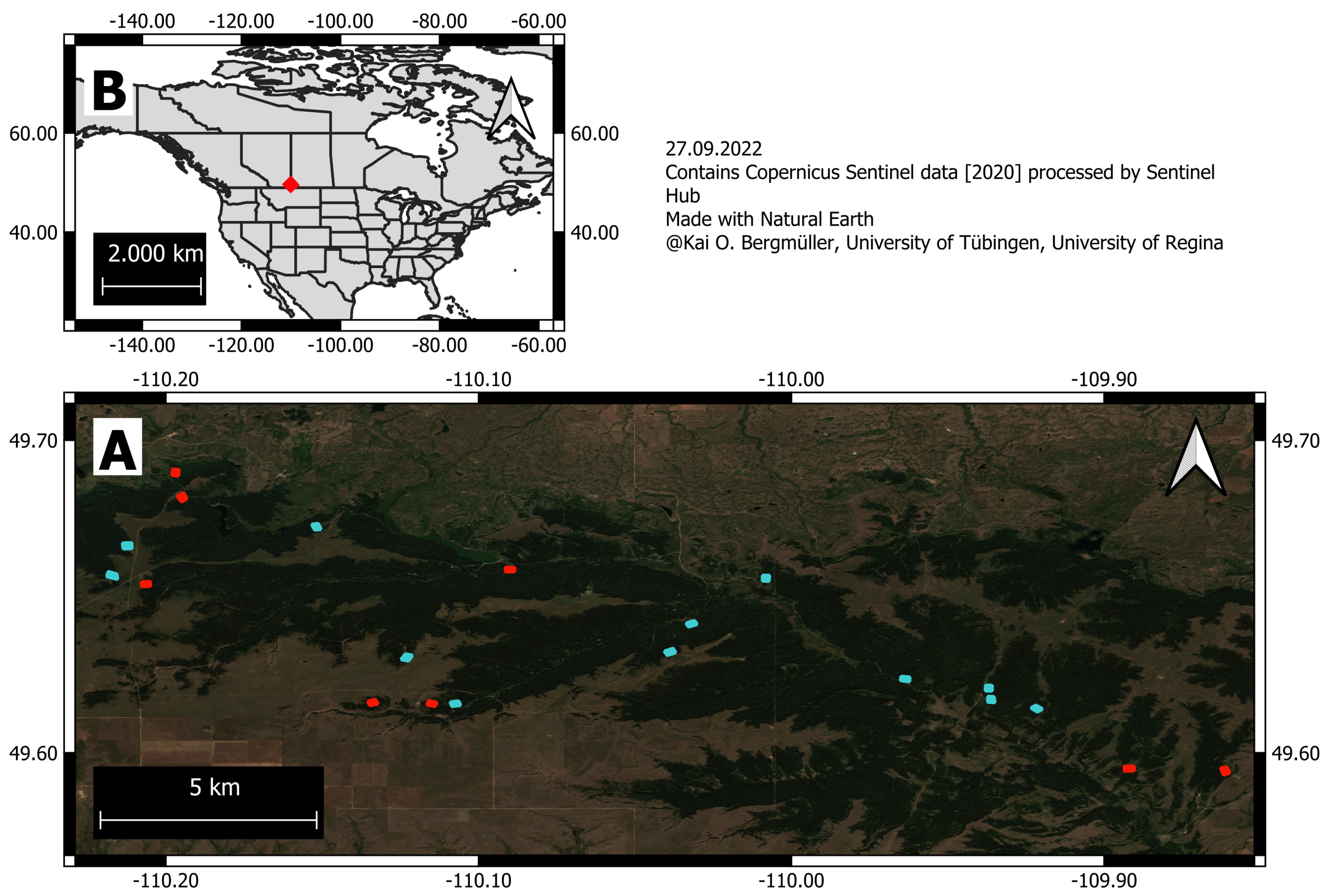
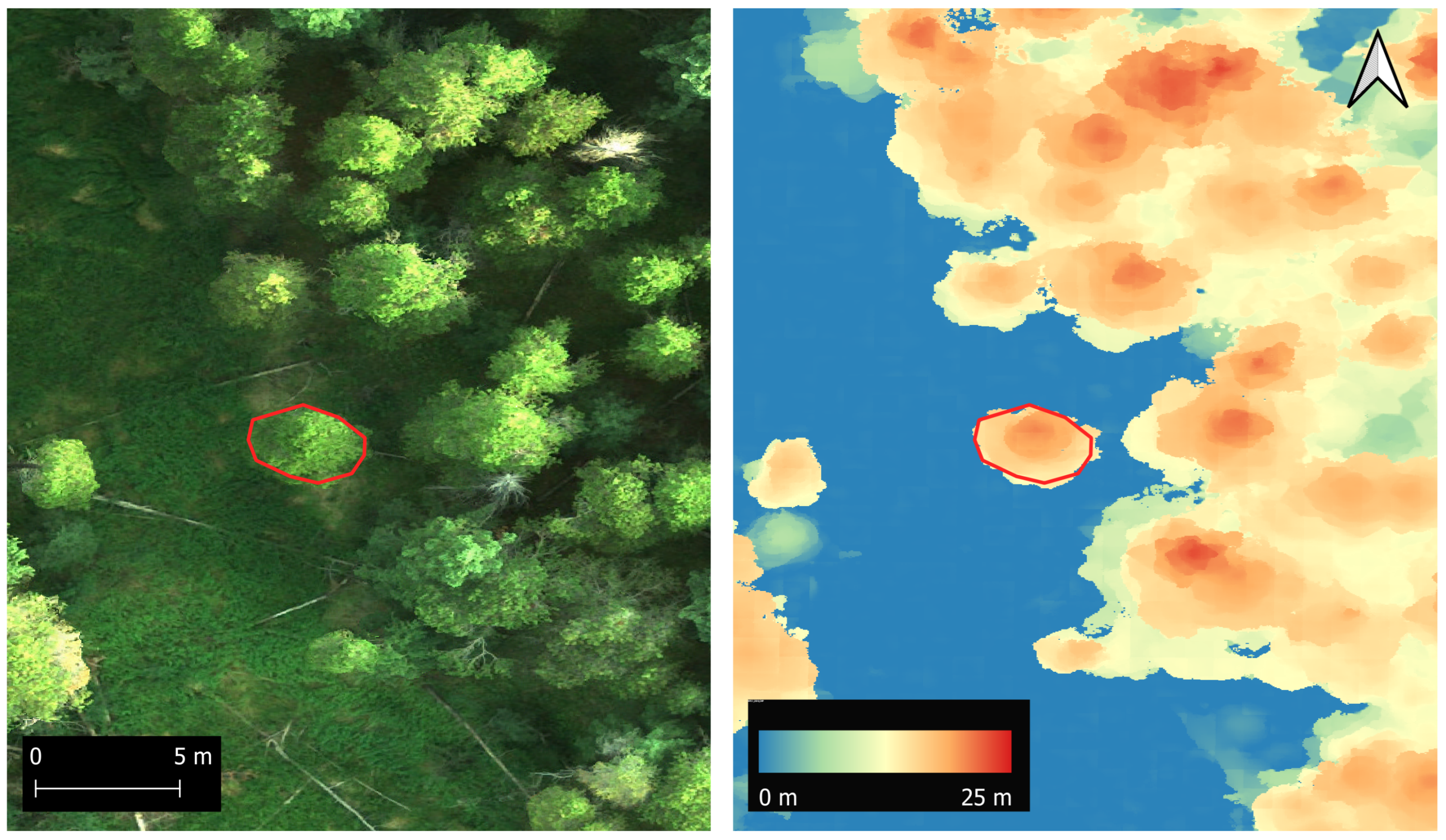

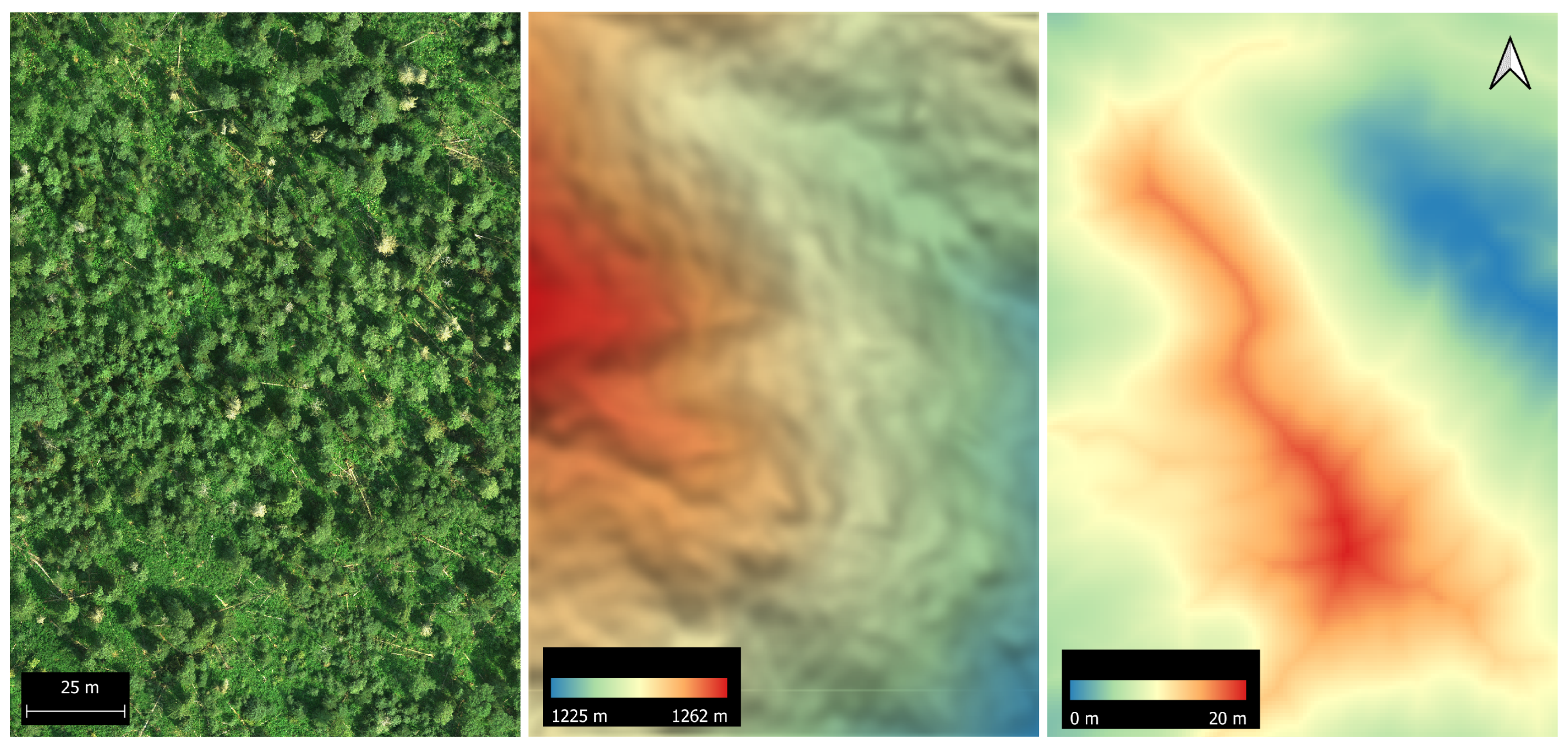
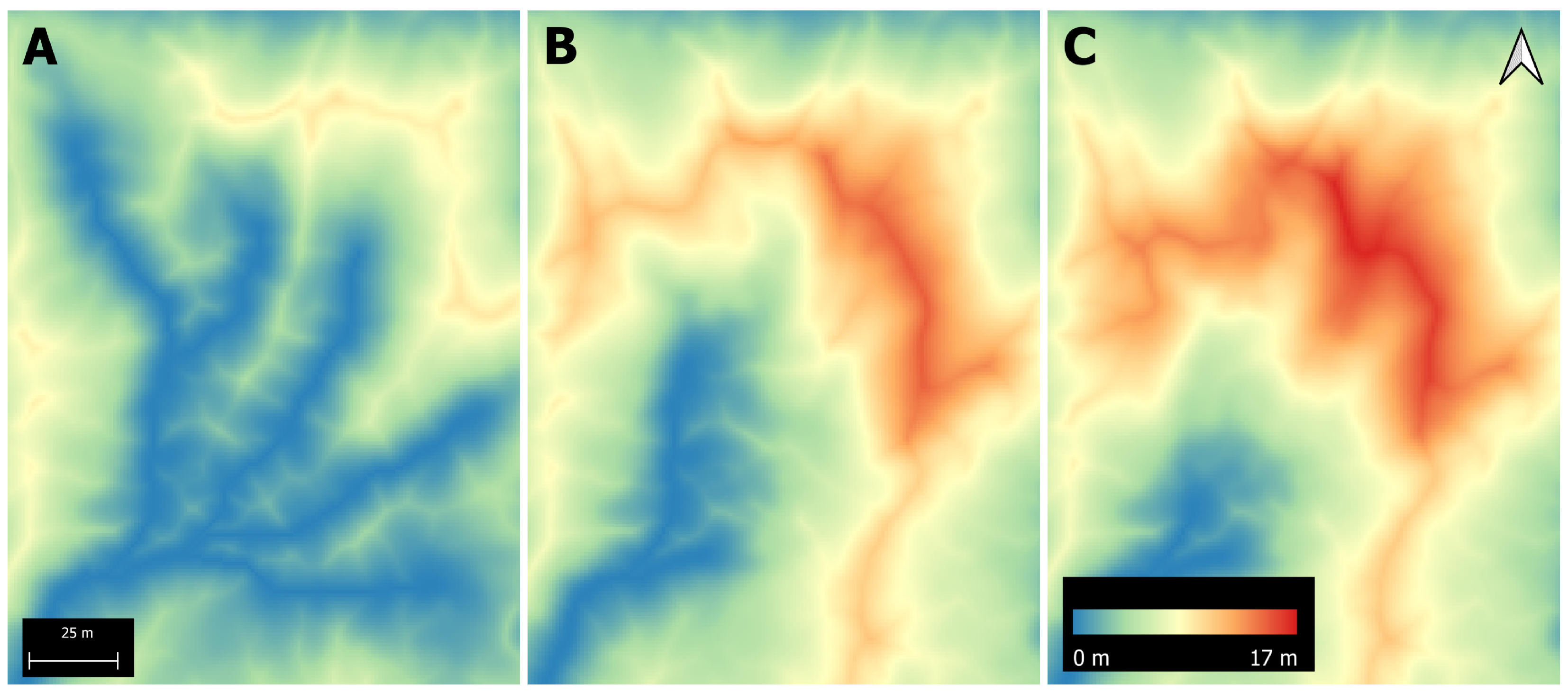

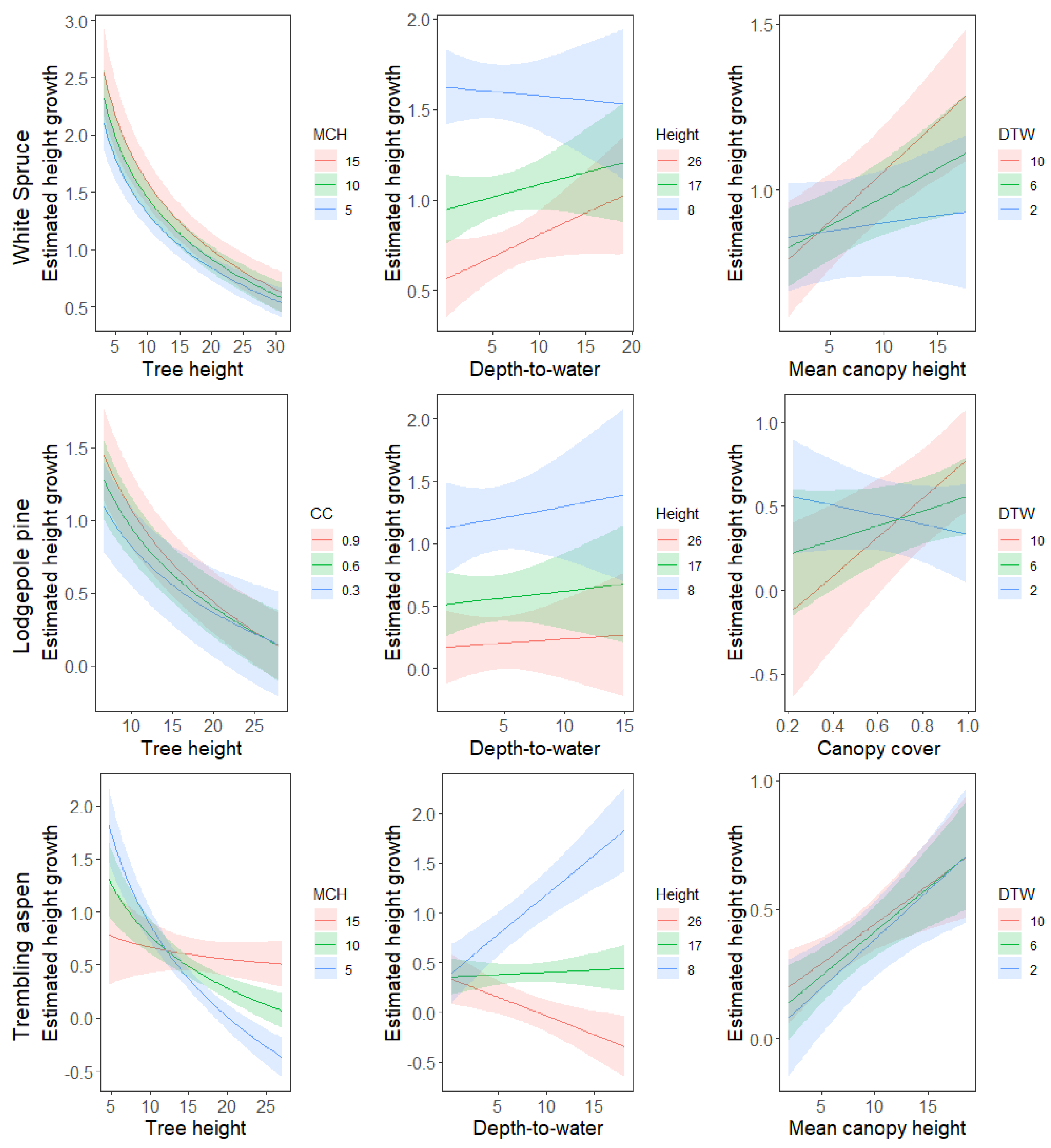
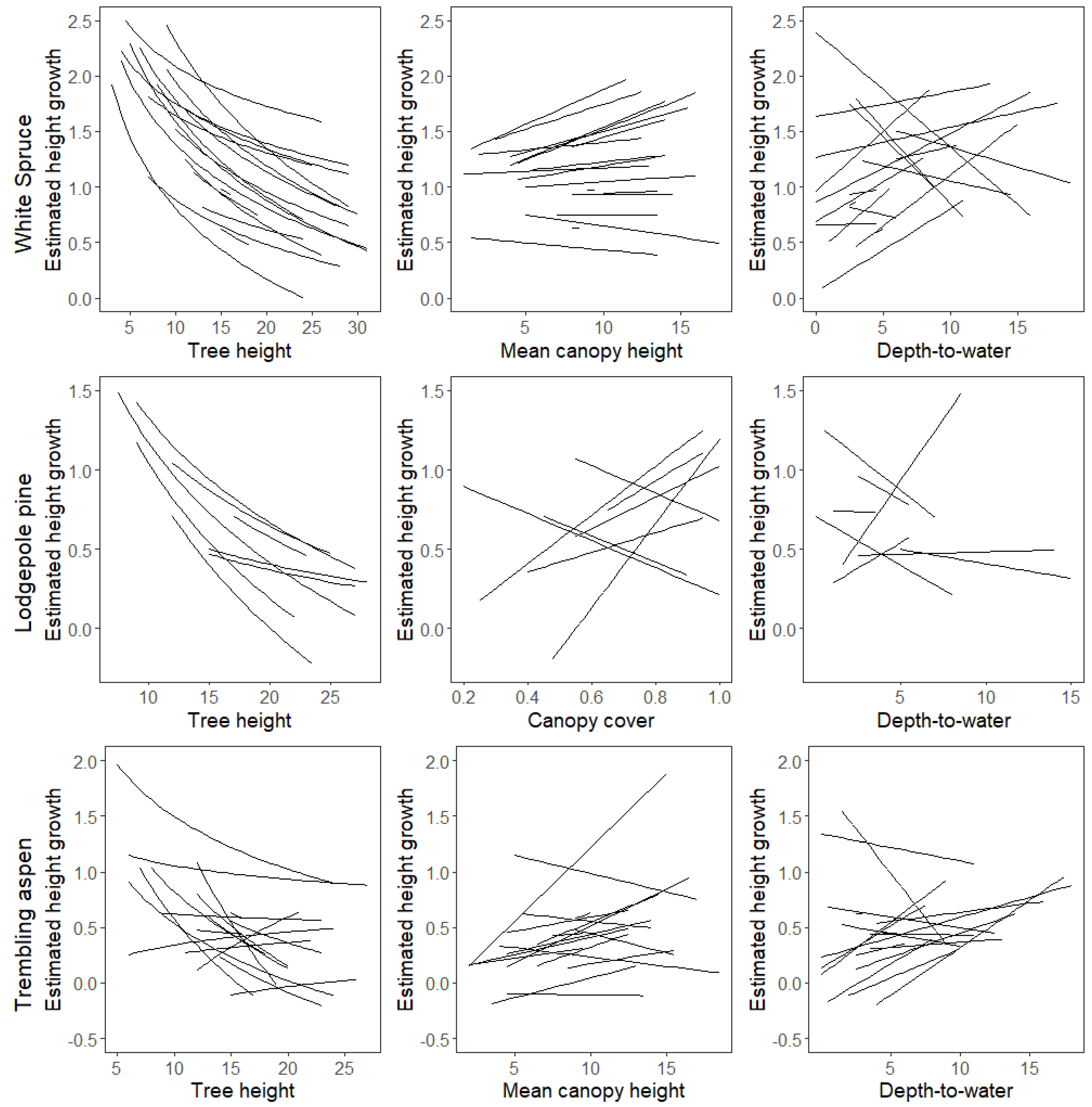
| NC Index a | Equation b | Dist. Dep. c | Size Dep. d | Examples |
|---|---|---|---|---|
| MCH | No | No | [14] | |
| CC | No | No | [11,12,14] | |
| CA | No | Yes | [12,14] | |
| CanAng | Yes | Yes | [12,14] |
| Flow Initiation Area [ha] | l-95% | u-95% | Bayes-R |
|---|---|---|---|
| 0.25 | −0.97 | 0.03 | 0.11 |
| 0.75 | −0.94 | −0.01 | 0.13 |
| 1.25 | −1.05 | 0.04 | 0.18 |
| White Spruce | Lodgepole Pine | Trembling Aspen | ||||
|---|---|---|---|---|---|---|
| Model a | ELPD-Diff b | SE c | ELPD-Diff b | SE c | ELPD-Diff b | SE c |
| MCH | 00.0 | 00.0 | −13.2 | 05.0 | −04.3 | 07.9 |
| CC | −00.4 | 02.9 | 00.0 | 00.0 | −08.4 | 08.8 |
| CA | −06.0 | 04.6 | −12.5 | 05.7 | −10.0 | 04.6 |
| Can Ang | −07.6 | 04.0 | −16.4 | 06.1 | 00.0 | 00.0 |
| Base + DTW | −07.5 | 04.6 | −17.8 | 06.6 | −35.1 | 09.6 |
| Base | −74.4 | 14.2 | −26.3 | 08.6 | −86.6 | 14.5 |
| Species a | MCH | CC | CA | CanAng | Base + DTW | Base |
|---|---|---|---|---|---|---|
| WS | 0.35 | 0.35 | 0.34 | 0.34 | 0.34 | 0.27 |
| LP | 0.23 | 0.25 | 0.23 | 0.23 | 0.22 | 0.20 |
| TA | 0.28 | 0.27 | 0.27 | 0.28 | 0.24 | 0.17 |
| Variable a | Estimate | Standard Error | l-95% b | u-95% c |
|---|---|---|---|---|
| White spruce | ||||
| −0.75 | 0.64 | −1.20 | −0.31 | |
| −0.09 | 0.06 | −0.19 | 0.02 | |
| 0.05 | 0.06 | −0.08 | 0.17 | |
| −0.02 | 0.02 | −0.06 | 0.02 | |
| 0.02 | 0.02 | −0.01 | 0.06 | |
| 0.00 | 0.00 | −0.00 | 0.01 | |
| Lodgepole pine | ||||
| −0.47 | 0.42 | −1.24 | 0.42 | |
| −0.10 | 0.16 | −0.41 | 0.24 | |
| 0.63 | 0.92 | −1.18 | 2.44 | |
| −0.44 | 0.34 | −1.11 | 0.23 | |
| −0.01 | 0.05 | −0.12 | 0.09 | |
| 0.18 | 0.08 | 0.04 | 0.33 | |
| Trembling aspen | ||||
| −1.12 | 0.44 | −1.95 | −0.25 | |
| 0.30 | 0.09 | 0.12 | 0.48 | |
| −0.27 | 0.10 | −0.47 | −0.08 | |
| 0.11 | 0.03 | 0.05 | 0.18 | |
| −0.10 | 0.03 | −0.17 | −0.03 | |
| 0.00 | 0.00 | −0.01 | 0.00 | |
Disclaimer/Publisher’s Note: The statements, opinions and data contained in all publications are solely those of the individual author(s) and contributor(s) and not of MDPI and/or the editor(s). MDPI and/or the editor(s) disclaim responsibility for any injury to people or property resulting from any ideas, methods, instructions or products referred to in the content. |
© 2023 by the authors. Licensee MDPI, Basel, Switzerland. This article is an open access article distributed under the terms and conditions of the Creative Commons Attribution (CC BY) license (https://creativecommons.org/licenses/by/4.0/).
Share and Cite
Bergmüller, K.O.; Vanderwel, M.C. Evaluating Effects of Remotely Sensed Neighborhood Crowding and Depth-to-Water on Tree Height Growth. Forests 2023, 14, 242. https://doi.org/10.3390/f14020242
Bergmüller KO, Vanderwel MC. Evaluating Effects of Remotely Sensed Neighborhood Crowding and Depth-to-Water on Tree Height Growth. Forests. 2023; 14(2):242. https://doi.org/10.3390/f14020242
Chicago/Turabian StyleBergmüller, Kai O., and Mark C. Vanderwel. 2023. "Evaluating Effects of Remotely Sensed Neighborhood Crowding and Depth-to-Water on Tree Height Growth" Forests 14, no. 2: 242. https://doi.org/10.3390/f14020242
APA StyleBergmüller, K. O., & Vanderwel, M. C. (2023). Evaluating Effects of Remotely Sensed Neighborhood Crowding and Depth-to-Water on Tree Height Growth. Forests, 14(2), 242. https://doi.org/10.3390/f14020242







